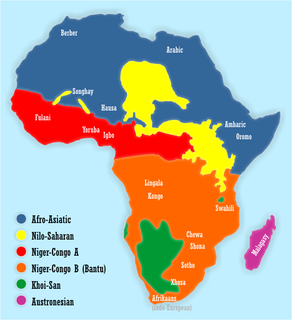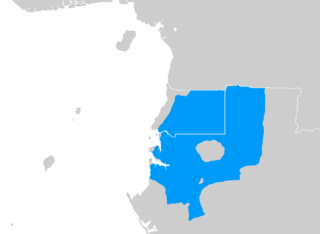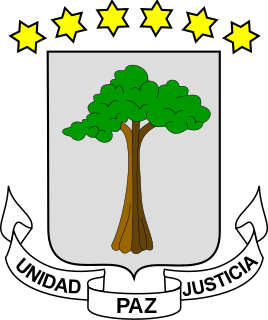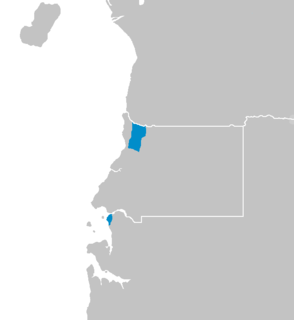Related Research Articles

The Bantu languages are a large family of languages spoken by the Bantu peoples in the southern half of Africa. They form the largest branch of the Southern Bantoid languages.

Equatorial Guinea, officially the Republic of Equatorial Guinea, is a country on the west coast of Central Africa, with an area of 28,000 square kilometres (11,000 sq mi). Formerly the colony of Spanish Guinea, its post-independence name evokes its location near both the Equator and the Gulf of Guinea. As of 2015, the country had a population of 1,225,367.

Fang is a Central African language spoken by around 1 million people, most of them in Equatorial Guinea, and northern Gabon, where it is the dominant Bantu language; Fang is also spoken in southern Cameroon, the Republic of the Congo, and small fractions of the islands of São Tomé and Príncipe. It is related to the Bulu and Ewondo languages of southern Cameroon.

The Makaa–Njem languages are a group of Bantu languages spoken in Cameroon, the Central African Republic, Equatorial Guinea, Gabon and the Republic of the Congo. They are coded Zone A.80 in Guthrie's classification.
Bube, Bohobé or Bube–Benga, is a Bantu language spoken by the Bubi, a Bantu people native to, and once the primary inhabitants of, Bioko Island in Equatorial Guinea. The language was brought to Bioko from continental Africa more than three thousand years ago when the Bubi began arriving on the island.

Articles related to Equatorial Guinea include:

Pichinglis, commonly referred to by its speakers as Pichi and formally known as Fernando Po Creole English (Fernandino), is an Atlantic English-lexicon Creole language spoken on the island of Bioko, Equatorial Guinea. It is an offshoot of the Krio language of Sierra Leone, and was brought to Bioko by Krios who immigrated to the island during the colonial era in the 19th century.
Kako is a Bantu language spoken mainly in Cameroon, with some speakers in the Central African Republic and the Republic of the Congo. The main population centres of Kako speakers are Batouri and Ndélélé in the East Region of Cameroon.
Benga is a Bantu language spoken by the Benga people of Equatorial Guinea and Gabon. It has a dialectal variation called Bapuku. Benga speakers inhabit a small coastal portion of Río Muni, the Cape of San Juan, suburban enclaves of Rio Benito and Bata, the islands of Corisco, Small Elobey and Great Elobey.
The Kombe language, or Ngumbi, is a Coastal Bantu language spoken by the Kombe people of Equatorial Guinea, one of the Ndowe peoples of the coast. It is mutually intelligible with Yasa.
Kombe people are an African ethnic group, members of the Bantu group, who are indigenous to Equatorial Guinea. They are native speakers of the Kombe language.
Lengue people, or Balengue, are an African ethnic group, members of the Bantu group, who are indigenous to Equatorial Guinea and Gabon. Their indigenous language is Lengue. Today Bengas inhabit the coast region of the country's mainland, between Bata and the Gabonese border. This ethnic group has become increasingly influence by Fang culture during the past couple of decades; but have maintained their linguistic identity. They are referred to as Ndowe or "Playeros", one of several peoples on the Rio Muni coast.

Seki, also Baseke, Sheke or Sekiana, is a language indigenous to Equatorial Guinea and Gabon. It had been spoken in villages of Rio Campo and Northern Bata, along the coast, but its native speakers have begun abandoning the language for Spanish, Fang, and Kombe. Can be related to Kako spoken in the East region of Cameroon and some parts of the west of Central African Republic.

The Kwasio language, also known as Ngumba / Mvumbo, Bujeba, and Gyele / Kola, is a language of Cameroon, spoken in the south along the coast and at the border with Equatorial Guinea by some 70,000 members of the Ngumba, Kwasio, Gyele and Mabi peoples. Many authors view Kwasio and the Gyele/Kola language as distinct. In the Ethnologue, the languages therefore receive different codes: Kwasio has the ISO 639-3 code nmg, while Gyele has the code gyi. The Kwasio, Ngumba, and Mabi are village farmers; the Gyele are nomadic Pygmy hunter-gatherers living in the rain forest.
Lengue may refer to:
Iyasa is a Bantu language spoken in Cameroon and Equatorial Guinea by the Iyasa and Ndowe coastal fishing peoples. It is also spoken by Pygmies, perhaps Babongo, in Gabon. Approximately 3,000 people speak Iyasa, though some note that this number may be an overestimation.
The Kele or Sheke languages are a clade of Bantu languages coded Zone B.20 in Guthrie's classification. According to Nurse & Philippson (2003), apart possibly from Seki (Sheke) (B.21) itself, the languages form a valid node. They are:

Bantu people are the speakers of Bantu languages, comprising several hundred indigenous ethnic groups in Africa, spread over a vast area from Central Africa, to Southeast Africa, and to Southern Africa.
Tanga, or Noho, is a Bantu language of Cameroon and Equatorial Guinea. Limba speakers report some degree of mutual intelligibility and call it "Old Malimba".
Kwakum is classified as belonging to the Bantu subgroup A90 (Kaka) of the Zone “A” Bantu languages, and specifically labelled A91 by Guthrie. According to one of the newest updates to the Bantu classification system, other languages belonging to this subgroup are: Pol (A92a), Pɔmɔ (A92b), Kweso (A92C) and Kakɔ (A93). The Kwakum people refer to themselves as either Kwakum or Bakoum. However, they say that the "Bakoum" pronunciation only began after the arrival of Europeans in Cameroon, though it is frequently used today. Kwakum is mainly spoken in the East region of Cameroon, southwest of the city Bertoua.
References
- ↑ Lengue at Ethnologue (18th ed., 2015)
- ↑ Jouni Filip Maho, 2009. New Updated Guthrie List Online
- Carlos González Echegaray. Estudios Guineos: Vol. II. Madrid: Consejo Superior de Investigaciones Cientificas 1959.
- Igor Cusack. "Hispanic and Bantu Inheritance, Trauma, Dispersal and Return: Some Contributions to a Sense of National Identity in Equatorial Guinea". Nations and Nationalism , Volume 5 Issue 2 Page 207 - April 1999.
- Quilis, Antonio y Celia Casado-Fresnillo. 1995. La lengua española en Guinea Ecuatorial. Madrid: Universidad Nacional de Educación a Distancia.